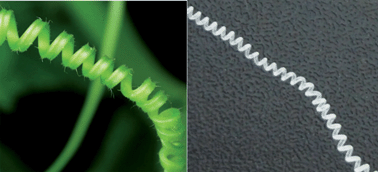Preparation of helical fibers from cellulose–cuprammonium solution based on liquid rope coiling
Abstract
A new method for large-scale mimicking of the helical structure of plant tendrils from cellulose solution was proposed based on liquid rope coiling of viscous fluid. In the spinning process, cellulose–cuprammonium solution was extruded from a certain height above a mobile coagulating bath. Helical structure was shown to form spontaneously at the surface of the coagulating bath as a result of buckling instability, and regenerated cellulose helical fiber was obtained after treatment with acid and air-drying. Spinning parameters, such as spinning height, flow rate and moving speed of the coagulating bath were examined in relation to the size and structure of the helical fiber. The microstructure of the helical fiber was further investigated by SEM. The diameters of the fiber and helix were found in the range of 100–400 and 300–700 μm, respectively. The helical fibers demonstrated high elongation at break and elasticity within a certain range of strain, which were attributed to the coiling structure. The microporous feature of the regenerated cellulose helical fiber shows potential as a helical scaffold and template for inorganic materials.


 Please wait while we load your content...
Please wait while we load your content...